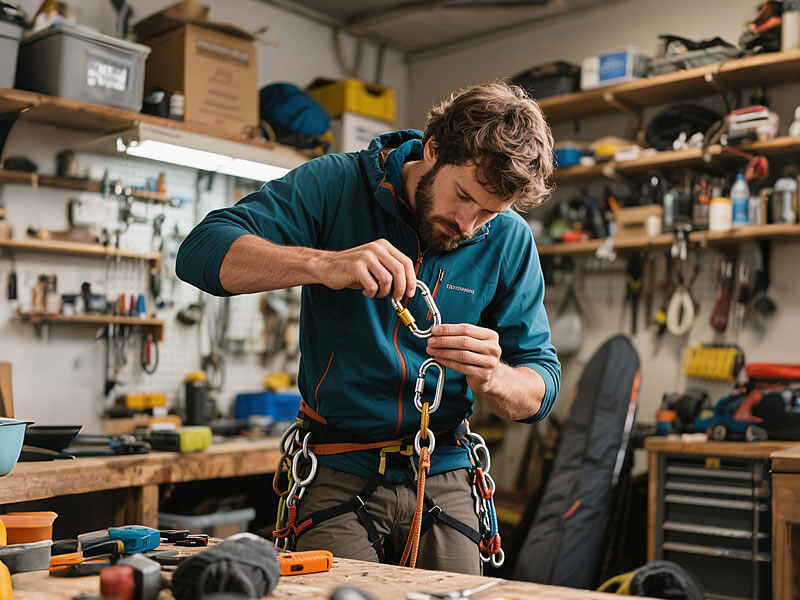Do climbing carabiners expire over time?
The short answer? No—carabiners don’t have an expiration date, but they do have a finite lifespan dictated by use, environment, and damage. Unlike climbing ropes or harnesses, which degrade predictably over time, carabiners can theoretically last decades. However, real-world factors like metal fatigue, corrosion, and wear turn “technically functional” into “dangerously unreliable.” Here’s how to gauge when to retire your gear.

Why Time Alone Doesn’t Kill Carabiners
Carabiners are forged from aluminum or steel alloys designed for longevity, but three factors drive aging:
- Cyclic Loading: Repeated stress (e.g., falls, rope drag) creates microscopic cracks.
- Environmental Exposure: Saltwater, UV rays, and acid rain corrode metal.
- Surface Damage: Rock strikes, grit in mechanisms, and improper storage.
A lab-tested carabiner stored in a dry closet could survive 50+ years. One used weekly on sea cliffs might fail in 3.
Lifespan by Usage Intensity
| User Profile | Avg. Lifespan | Critical Risk Factors |
|---|---|---|
| Professional Guide | 2-4 years | Daily falls, abrasive sand |
| Sport Climber | 5-7 years | Frequent whippers, gym chalk |
| Trad Climber | 8-10 years | Occasional use, minimal falls |
| Coastal Ice Climber | 3-5 years | Saltwater, freeze-thaw cycles |
Steel carabiners last 50% longer but are heavier.
The Silent Killers: Invisible Damage
Even pristine-looking carabiners can fail due to:
- Metal Fatigue: UIAA tests show aluminum loses 10-15% strength after 5 years of moderate use.
- Stress Corrosion Cracking (SCC): Chemical exposure (e.g., urine, battery acid) causes internal fractures.
- Gate Spring Fatigue: Auto-locking mechanisms lose tension after 10,000+ cycles.
The 5-Second Inspection Protocol
Monthly checks prevent surprises:
- Visual: Look for cracks, grooves ≥1mm, or discoloration.
- Tactile: Run a cotton swab over edges—snags indicate burrs.
- Gate Test: Open/close 10x; sticky or gritty action = trouble.
- Sound: Tap with a metal key; a dull “thud” suggests internal cracks.
When to Retire Immediately (No Exceptions)
- After a Hard Fall: Forces >8 kN (common in lead falls).
- Visible Corrosion: Pitting, rust, or chalky residue (aluminum oxide).
- Gate Malfunction: Doesn’t close smoothly or locks unreliably.
- Rope Damage: Sheath fibers fray from sharp edges.
Extending Carabiner Life: Pro Tips
- Rinse After Saltwater: Use fresh water, dry thoroughly.
- Lubricate Sparingly: Silicone spray on hinges every 3 months.
- Avoid Ground Contact: Dirt accelerates wear.
- Rotate Gear: Use older carabiners for non-critical tasks (e.g., gear loops).
Case Study: The 20-Year-Old “Safe” Carabiner
In 2021, a climber’s vintage aluminum carabiner snapped during a routine top-rope ascent. Lab analysis revealed:
- Hidden Cracks: From 15+ years of UV exposure.
- Gate Spring Failure: Only 30% of original tension.
- Sheath Damage: Rope cuts reduced spine strength by 40%.
Expert Insights
“Treat carabiners like parachutes—retire them at the first sign of doubt. Metal doesn’t age like wine; it ages like milk.”—Tommy Caldwell, Big Wall Climber
The Future: Smart Carabiners
Innovations to monitor lifespan:
- RFID Chips: Track usage cycles and fall history.
- Micro-Strain Sensors: Alert when cracks form.
- Biodegradable Alloys: Eco-friendly metals that signal wear via color changes.
While climbing carabiners don’t expire on a calendar, their operational lifespan hinges on rigorous care. For those who push limits, err on the side of caution: Replace gear every 5-7 years regardless of visible wear. As the UIAA warns: “A carabiner’s history matters more than its age.”






